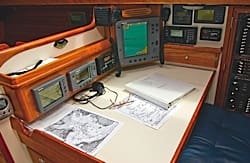On the user side, Global Positioning System (GPS) technology has become so small and effective it has seemed to almost disappear. The few microchips that comprise a “GPS engine” can be added to virtually any product, giving it positioning and precise time capability. So effective has GPS been that some users might think of it as a law of nature, like gravity. It’s just there and we, as voyagers, only need tap into it.
A recent report from the Department of Defense (DoD), however, raises a few warning flags about the space-based leg of the system: the satellites. Some bad breaks and the satellite leg could find itself significantly degraded. Should that happen, all that excellent GPS user equipment could be less useful than we have come to expect.
Every two years, DoD is required to present to the House and Senate a report on the status of specific elements of GPS. The latest report was sent to Congress on Oct. 31, 2008. Halloween was a fitting delivery date given one potentially scary scenario suggested by the report.
GPS was designed to be most effective when a full constellation of 24 operational satellites are in orbit. With 24 birds circling the earth, users get good satellite geometry and reliable and accurate fixes. With less than 24 spacecraft flying, coverage and, thus, accuracy is degraded. To ensure that there are always 24 birds available, Air Force Space Command’s 2nd Space Operations Squadron, which runs the GPS satellite constellation from Schriever Air Force Base in Colorado, has 31 satellites in orbit — 13 Block IIA’s, 12 Block IIR’s and six Block IIR-M’s. This gives the GPS constellation the needed 24, plus seven in-orbit spares. The spares can be turned on should one of the operational 24 spacecraft experience a major systems failure.
It is this last point, the possibility of a major systems failure on board the GPS satellites, that is sobering to a reader of the recent GPS report. Even though there are seven in-orbit spares, the possibility exists for as many as 19 satellites to have serious problems that would take them out of service. The reports states: “Of the 31 GPS satellites currently on orbit, 20 are past their design life, and 19 are without redundancy in either the navigation mission equipment or the satellite bus, or both.”
Space is a harsh environment, and the systems on satellites do fail over time. Failures can occur from micrometeorite strikes, due to powerful bursts of charged particles from the sun, or simply old age — 20 of the 31 satellites in orbit have exceeded their design lives and others are approaching that status. Because satellite systems can fail and the high-flying GPS birds can’t be repaired by the low-flying Space Shuttle, these spacecraft are built with duplicate systems. When a system fails, the controllers can switch to a backup system.
The phrase “without redundancy” quoted above means that GPS controllers are on their last line of defense with 19 of the 32 satellites. Should one more critical system fail with either the navigational electronics or with some system that keeps the satellite pointed in the right direction, in the proper orbit, or supplied with electrical power, the satellite will no longer be able to fulfill its role. It is possible, therefore — though not likely — that more than seven of these “hanging by a single thread” birds could fail. Should that occur, GPS controllers would not have sufficient spares in orbit to cover the failed birds and a gap in coverage would result. Luckily, the odds of eight or more satellites failing within a short time of each other is fairly remote. Not only that, but the Air Force has two Block IIR-M satellites on the ground that it can launch as replacements. And there are 12 Block IIF satellites in various stages of production. So, in the short term, GPS looks pretty safe.
However, also mentioned in the report is the looming possibility that the follow-on generation of satellites, the GPS III spacecraft, might be late in getting built and launched: “Should delivery and launch of the next generation space and control segments be delayed, sustainment of the GPS constellation will be difficult, and the constellation population could fall below the 24 satellites necessary to meet published performance standards.” And if the system does not have the 24 satellites in orbit that it needs for optimum geometry and coverage, then GPS ceases to be the reliable force of nature it is now.
Of course, the gap might never open if the current crop of satellites keep operating as effectively as they have and if the Block IIF units follow their lead. Clearly, after promoting GPS as a reliable civil navigation tool, a period of less than complete 24-satellite coverage would be an embarrassment to the DoD and the U.S. government. And such a gap might provide an opening for other satellite systems, such as the Galileo system from the European community, Global Navigation Satellite System (GLONASS) from Russia and Compass from China, to gain a foothold versus GPS.
Another interesting aspect of this GPS status report is the acknowledgment that the Department of Homeland Security has designated enhanced loran (eloran) as “a national backup to GPS.” Eloran is an approach that allows properly equipped receivers to use all the loran stations in view, rather than the older approach of only using stations from a specific chain.

